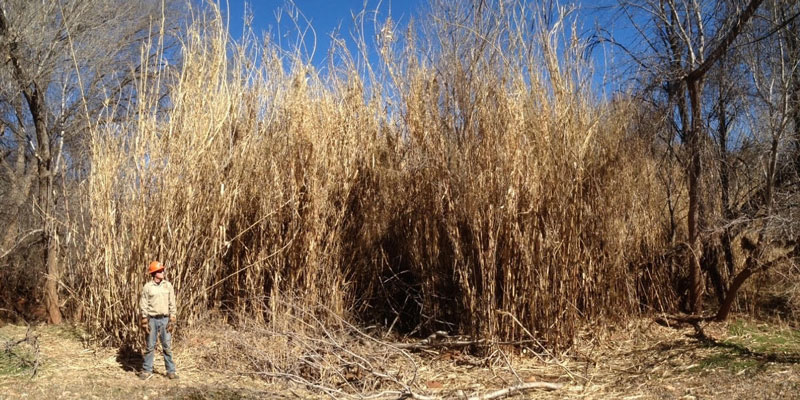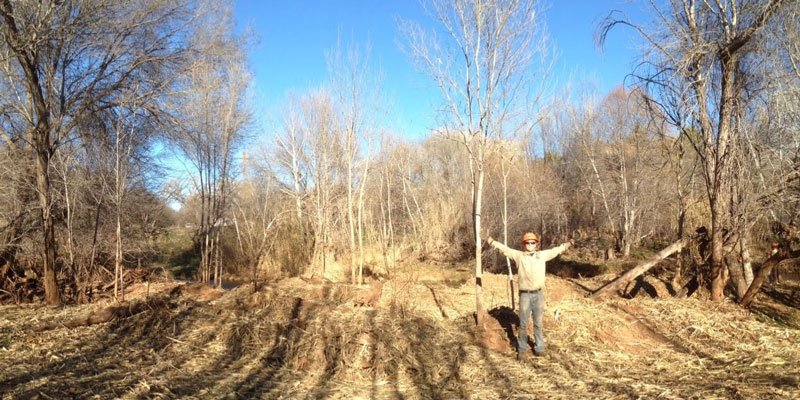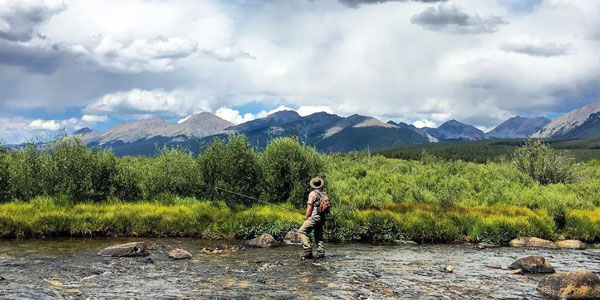
One of Arizona’s few remaining perennial rivers, the Verde, is home to an amazing diversity of wildlife. Nearly half of the state’s bald eagle nest territories are located along the river. Roughly 10 percent of Arizona’s rarest forest type—the species-rich Fremont Cottonwood/Goodding Willow habitat—can be found along its banks.
The upper Verde is still relatively remote and isolated. As is flows south, it winds its way through the beautiful and arid landscape southwest of Sedona, Arizona. Its flow provides a lush, green corridor of plants and is home to at least 270 species of birds, 94 species of mammals and 76 species of native amphibians and reptiles. Over 60 miles of the river is federally protected under the Wild & Scenic Act.
Yet the Verde River is in danger of running dry.
For the second year in a row, Forever Our Rivers provided a grant to Friends of the Verde River to help them remove giant reed (Arundo donax), along Oak Creek, which flows into the middle Verde from the east.
One of the fastest-growing terrestrial plants in the world, giant reed competes with native cottonwood and willow for moisture, suppressing the success of native seedlings. Giant reed’s stem and leaves contain a variety of nasty chemicals, rendering it unsuitable as food or nesting habitat for wildlife. It offers less shade than cottonwood and willows, contributing to higher water temperatures. And even worse, dense, woody stands of giant reed are very susceptible to high-intensity wildfire.
“Wildfire is typically rare along rivers. However, it is becoming more common around the state,” said Willie Sommers, invasive plant program coordinator of the Arizona Department of Forestry and Fire Management, who partners with Friends of the Verde. “Removing giant reed checks a lot of boxes—improved wildlife habitat, reduced risk of wildfire and improved access for recreation,” Sommers said.
Neighboring landowner Dean Bowen agrees. “We had a fire across the creek in Cornville that exploded to about 1,500 acres in a matter of three or four hours,” said Bowen. Shortly thereafter, he and his neighbors instituted a community evacuation call system, just in case.
Friends of the Verde collaborates with the department and Arizona Conservation Corps, Verde Earth Technologies and Conservation Legacy field crews. Together they monitor previously infested areas of the watershed and treat any resprouts, leveraging previous investments of $4.5 million and months of efforts on more than 10,500 riparian acres.
Forever Our Rivers funding will support treatments on 15 river miles of Oak Creek. “There is very limited water—and every drop is important,” said Tracy Stephens, program director for Friends of the Verde River. “There is no room for noxious plants.”

Collaboration Creates Big Win for Rivers

River enthusiasts across Colorado celebrated National River’s month with an “Outstanding Waters” protection for the headwaters of Taylor River and lower Soap Creek, which feeds into Blue Mesa Reservoir.
The designation was awarded by the Colorado Water Quality Control Commission in June, following a rigorous three-year process. The Southwest Colorado Outstanding Waters Coalition put forth the proposal, in collaboration with local, state and national water conservationists.

An impressive total of 520 river miles in the Gunnison, Upper Dolores, San Juan, San Miguel and Animas watersheds were permanently protected.
The Outstanding Waters award is focused on water quality. Among other criteria, water must be of “exceptional recreational or ecological significance”. While downstream users benefit from the high-quality water, the designation does not affect their water rights.
More information can be found in this article published by the Gunnison Country Times.
